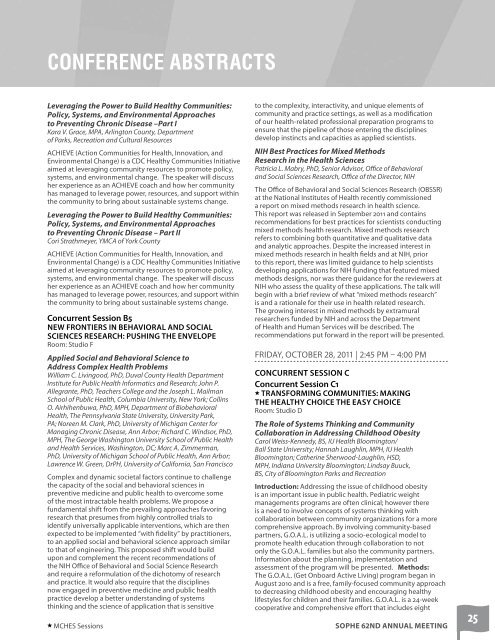Download - Society for Public Health Education
Download - Society for Public Health Education
Download - Society for Public Health Education
- No tags were found...
Create successful ePaper yourself
Turn your PDF publications into a flip-book with our unique Google optimized e-Paper software.
Conference AbstractsLeveraging the Power to Build <strong>Health</strong>y Communities:Policy, Systems, and Environmental Approachesto Preventing Chronic Disease –Part IKara V. Grace, MPA, Arlington County, Departmentof Parks, Recreation and Cultural ResourcesACHIEVE (Action Communities <strong>for</strong> <strong>Health</strong>, Innovation, andEnvironmental Change) is a CDC <strong>Health</strong>y Communities Initiativeaimed at leveraging community resources to promote policy,systems, and environmental change. The speaker will discussher experience as an ACHIEVE coach and how her communityhas managed to leverage power, resources, and support withinthe community to bring about sustainable systems change.Leveraging the Power to Build <strong>Health</strong>y Communities:Policy, Systems, and Environmental Approachesto Preventing Chronic Disease – Part IICori Strathmeyer, YMCA of York CountyACHIEVE (Action Communities <strong>for</strong> <strong>Health</strong>, Innovation, andEnvironmental Change) is a CDC <strong>Health</strong>y Communities Initiativeaimed at leveraging community resources to promote policy,systems, and environmental change. The speaker will discussher experience as an ACHIEVE coach and how her communityhas managed to leverage power, resources, and support withinthe community to bring about sustainable systems change.Concurrent Session B5New Frontiers in Behavioral and SocialSciences Research: Pushing the EnvelopeRoom: Studio FApplied Social and Behavioral Science toAddress Complex <strong>Health</strong> ProblemsWilliam C. Livingood, PhD, Duval County <strong>Health</strong> DepartmentInstitute <strong>for</strong> <strong>Public</strong> <strong>Health</strong> In<strong>for</strong>matics and Research; John P.Allegrante, PhD, Teachers College and the Joseph L. MailmanSchool of <strong>Public</strong> <strong>Health</strong>, Columbia University, New York; CollinsO. Airhihenbuwa, PhD, MPH, Department of Biobehavioral<strong>Health</strong>, The Pennsylvania State University, University Park,PA; Noreen M. Clark, PhD, University of Michigan Center <strong>for</strong>Managing Chronic Disease, Ann Arbor; Richard C. Windsor, PhD,MPH, The George Washington University School of <strong>Public</strong> <strong>Health</strong>and <strong>Health</strong> Services, Washington, DC; Marc A. Zimmerman,PhD, University of Michigan School of <strong>Public</strong> <strong>Health</strong>, Ann Arbor;Lawrence W. Green, DrPH, University of Cali<strong>for</strong>nia, San FranciscoComplex and dynamic societal factors continue to challengethe capacity of the social and behavioral sciences inpreventive medicine and public health to overcome someof the most intractable health problems. We propose afundamental shift from the prevailing approaches favoringresearch that presumes from highly controlled trials toidentify universally applicable interventions, which are thenexpected to be implemented “with fidelity” by practitioners,to an applied social and behavioral science approach similarto that of engineering. This proposed shift would buildupon and complement the recent recommendations ofthe NIH Office of Behavioral and Social Science Researchand require a re<strong>for</strong>mulation of the dichotomy of researchand practice. It would also require that the disciplinesnow engaged in preventive medicine and public healthpractice develop a better understanding of systemsthinking and the science of application that is sensitiveMCHES Sessionsto the complexity, interactivity, and unique elements ofcommunity and practice settings, as well as a modificationof our health-related professional preparation programs toensure that the pipeline of those entering the disciplinesdevelop instincts and capacities as applied scientists.NIH Best Practices <strong>for</strong> Mixed MethodsResearch in the <strong>Health</strong> SciencesPatricia L. Mabry, PhD, Senior Advisor, Office of Behavioraland Social Sciences Research, Office of the Director, NIHThe Office of Behavioral and Social Sciences Research (OBSSR)at the National Institutes of <strong>Health</strong> recently commissioneda report on mixed methods research in health science.This report was released in September 2011 and containsrecommendations <strong>for</strong> best practices <strong>for</strong> scientists conductingmixed methods health research. Mixed methods researchrefers to combining both quantitative and qualitative dataand analytic approaches. Despite the increased interest inmixed methods research in health fields and at NIH, priorto this report, there was limited guidance to help scientistsdeveloping applications <strong>for</strong> NIH funding that featured mixedmethods designs, nor was there guidance <strong>for</strong> the reviewers atNIH who assess the quality of these applications. The talk willbegin with a brief review of what “mixed methods research”is and a rationale <strong>for</strong> their use in health related research.The growing interest in mixed methods by extramuralresearchers funded by NIH and across the Departmentof <strong>Health</strong> and Human Services will be described. Therecommendations put <strong>for</strong>ward in the report will be presented.Friday, October 28, 2011 | 2:45 pm – 4:00 pmConcurrent Session CConcurrent Session C1Trans<strong>for</strong>ming Communities: Makingthe <strong>Health</strong>y Choice the Easy ChoiceRoom: Studio DThe Role of Systems Thinking and CommunityCollaboration in Addressing Childhood ObesityCarol Weiss-Kennedy, BS, IU <strong>Health</strong> Bloomington/Ball State University; Hannah Laughlin, MPH, IU <strong>Health</strong>Bloomington; Catherine Sherwood-Laughlin, HSD,MPH, Indiana University Bloomington; Lindsay Buuck,BS, City of Bloomington Parks and RecreationIntroduction: Addressing the issue of childhood obesityis an important issue in public health. Pediatric weightmanagements programs are often clinical; however thereis a need to involve concepts of systems thinking withcollaboration between community organizations <strong>for</strong> a morecomprehensive approach. By involving community-basedpartners, G.O.A.L. is utilizing a socio-ecological model topromote health education through collaboration to notonly the G.O.A.L. families but also the community partners.In<strong>for</strong>mation about the planning, implementation andassessment of the program will be presented. Methods:The G.O.A.L. (Get Onboard Active Living) program began inAugust 2010 and is a free, family-focused community approachto decreasing childhood obesity and encouraging healthylifestyles <strong>for</strong> children and their families. G.O.A.L. is a 24-weekcooperative and comprehensive ef<strong>for</strong>t that includes eightSOPHE 62nd Annual Meeting25
















